Mehendi is an ancient art of drawing on the body. Its exact origin has not been clarified - some researchers believe that it comes from India, while others refer it to the times of Ancient Egypt. Its inhabitants believed that the bizarre ornaments on the body would provide them with an unhindered path to another world, and the recipe for preparing the mixture for drawing the priests was kept in strict secrecy.
Today, every woman can make mehendi at home - for this you need a special dye, a knowledge of the technique of applying it, and also a little imagination and creativity.
Mehendi in video - how it looks like it is applied:Technique and rules for applying mehendi
The advantage of this art is that unlike tattoos, mehendi does not last very long on the skin, therefore it is great for those who do not want or do not wantcan decorate his body with a permanent image.
To learn the technique of painting the body using natural pigments( henna, basma, etc.) is easy enough, but it requires observance of some important rules, first of all, the correct preparation of the place for drawing.
You can draw mehendi on the leg, arm, shoulder, abdomen, etc., but beforehand it is necessary to perform the following manipulations:
- One day before making mehendi, it is better to refrain from visiting the solarium or intensive exposure to ultraviolet radiation.
- To make a painting in the same place, you can not more often than 2 times a month - in spite of the fact that henna and other dyes for mehendi are natural, experts believe that the skin should sometimes rest from the effects of pigments.
- The place of the pattern is not recommended to be treated with any moisturizers. It must be washed with soap and then wiped with an alcohol-containing solution. If the skin is rough and uneven, the place should be treated with a scrub or at least thoroughly rubbed with a stiff washcloth.
- You can make a drawing with a cone( slightly similar to a pastry syringe for cakes) or with chopsticks of different thicknesses. Cone is also quite easy to do on your own - for this purpose, conventional thick paper or even foil, which is curled into a pocket and is well fixed with adhesive tape or adhesive plaster. The sharpened edge should be cut so that the hole of the smallest diameter is obtained or simply pierced with a thick needle.
Recipe for a mix for mehendi at home
A pledge of a successful and bright pattern - correctly prepared pasta for mehendi. The main component for it is the usual henna, which can be bought at any cosmetic store.
In the first case, the "tattoo" will be almost black, and in the second case - less resistant, but more useful for health. Such a picture can be made for those who suffer from thyroid disorders or in a place where there is any damage to the skin( for example, a bruise or bruise) - this will help to mask the defect and cure it more quickly.
The quality of henna powder is one of the most important rules of successful drawing. In eastern countries, for which the art of mehendi is considered to be "native," painting is done with a special henna intended for this purpose.
How to make henna for mehendi - a recipe in the video:In our region, this dye is sometimes sold in specialized stores, but most often it is necessary to draw henna for dyeing hair. The powder must be very finely ground, so it must be sifted through a fine strainer or even thinned( for this you should use only old, unnecessary dishes, since it will be practically impossible to wash henna from the surface).
There is not one recipe for preparing a mixture for mehendi, but the most common is the following method.
Ingredients:
- juice of 1 lemon;
- sugar - 2 tbsp.a spoon;
- henna - about 20 g.
You can use the henna recipe for mehendi without lemon and instead add half a cup of strong tea brewing( the so-called chifir).
In addition, the recipe sometimes includes tincture of green walnut peel, red wine or brewed coffee - depending on these additives, the mehendi turns black, reddish or dark brown. 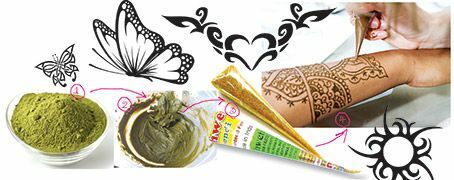
- To make a paste for drawing, mix lemon juice( or tea brew) with sugar.
- Then gradually add the powder of henna, mixing well so that a thick, viscous mass without lumps is obtained.
- After this, it should be kept warm for a day and put into a cone.
How to make stencils for mehendi?
The easiest way to make a beautiful, clear painting on the body to those who only master this art is to use a stencil. It can be bought or manufactured independently from self-adhesive film or thin plastic.
On the chosen material, you need to draw the selected drawing, then put it on a wooden board and cut the "extra" elements with a sharp paper knife, trying to make the lines smooth and without serifs, which then will be very difficult to get rid of.
Sketches for mehendi
There are several traditional styles of mehendi, of which it is very easy to choose the most suitable.
- Arabic style.
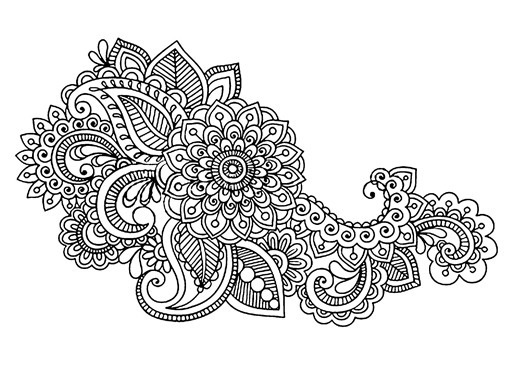
Arabic sketch for mehendi
It is very popular in the Middle East, and mainly consists of plant motifs. As a rule, such drawings are done arbitrarily and do not have a clear pattern of application.
- African style. Ethnic ornaments of North African peoples are stylized geometric figures and flowers.
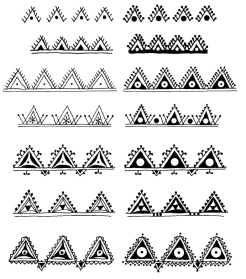
African sketches for mehendi
- Indian style. Drawing Indian mehendi is most difficult, since it usually covers a very large area( usually from the tips of the toes to the very top) and look like solid stockings and gloves. The basic elements are religious motifs( for example, an elephant), signs of fertility( ear, Indian cucumber), drawings in the form of drops.
- Asian style. Such figures are characterized by dots on the fingers and toes, and the lateral parts of the limbs are completely obscured by the dye.
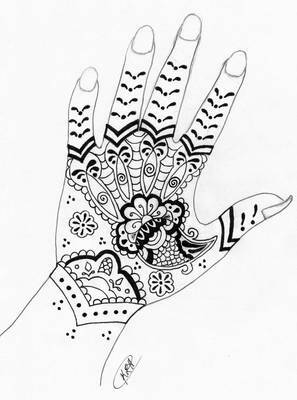
Asian sketch for mehendi
- European style. The most diverse and innovative style of painting, representing a mix of oriental elements, as well as abstraction, hieroglyphs, etc.

European sketch for mehendi
Painting mehendi on hand step by step for beginners
To make a mehendi drawing for beginners, it is worthwhile to find on the Internet a master classwith video. There you can visually see how to cook mehendi at home, how to apply the selected pattern on the skin, how to dry and much more.
Before drawing images on the body, it is better to practice first on paper or glass - first draw straight lines, then curved, flowers, waves, etc. And only after that you can proceed directly to the painting.
- Protect clothing from dye penetration, since henna is removed from the tissue very difficult.
- Prepare a pasta for mehendi, choosing the most suitable recipe for this.
- Allow the mixture to stand and put it into a cone.
- Appropriate preparation of the place to be painted.
- Expand all tools to work near you.
- If a stencil is used for the mehendi, it should be well attached to the skin or the contours of the pattern be traced with a cosmetic pencil( for eyebrows or eyes).
- Start drawing, evenly squeezing the paste from the wide end of the tube, and add the finest elements with toothpicks or thin sticks. If some element does not work out, it must be immediately wiped off with a cotton swab until henna colored the skin.

- To achieve different shades of paint, the paste should be applied in layers of different thicknesses.
- After the pattern is applied, the mixture should be allowed to dry as long as possible, ideally for 6-8 hours. You can leave it for the night - for convenience, it's better to sprinkle the hair with strong hairspray, then wait for it to dry and sprinkle again, and then tightly( but not tighten!) Wrap your hand with polyethylene.
- Remove henna from the skin with a wooden stick.
- Lubricate the pattern with eucalyptus, almond or sesame oil - they contribute to better penetration of the pigment under the skin and increase the brightness of the image.
- To keep the "tattoo" as long as possible, after removing the paint, avoid contact with water for at least 4 hours.
Many people are interested in the question: how much is the pattern on the skin? Here everything depends on the place on which it was applied: for example, it lasts longer on the palms of the hand, and is most quickly washed off from the back and abdomen. On the average, properly cooked and dried henna can maintain brightness for 10-14 days.
Application of mehendi at home - video:Is it possible to wash mehendi?
Unfortunately, immediately get rid of the pictures of henna will not work. The process can be accelerated by scrubbing, intensive washing with soap, and using natural bleaching agents - citric acid, cucumber, parsley root.
In extreme cases, you can take hydrogen peroxide, but there is a high probability of getting irritation or even a skin burn.
How to take care of mehendi?
- Heat makes the shade of the picture deeper and more saturated, so when drying it is better to keep it under the sun or infrared lamp.
- You should not bathe in salted or chlorinated water( that is, in the sea or in the pool), otherwise the pattern will come off too quickly.
- It is not necessary to take a hot bath often( it is better to do with a warm shower) and do not soap the places with the pattern applied, but slightly rinse them with warm water.
- Before water procedures, it is better to lubricate mehendi with some vegetable oil, which will protect the figure from fading. Vaseline, baby oil and other similar products should not be used for this.
- The location of the drawing should not be shaved or epilated until it is completely gone.
- If the pattern has strongly faded, it can be resumed using the same contour, but it is not recommended to do this more than 2 times.
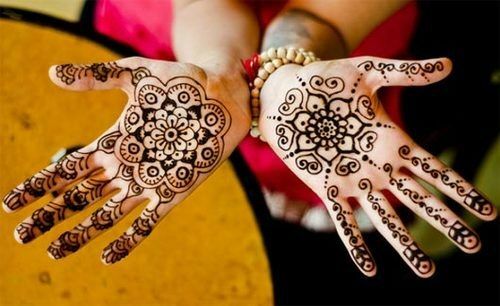
Mehendi is a very beautiful and simple enough way to make your image original without the pain and discomfort that usually accompanies conventional tattoos.
Reviews about the drawings of henna among body art lovers are the best, so you definitely need to try to make it yourself! Related Videos:
 3:31
3:31 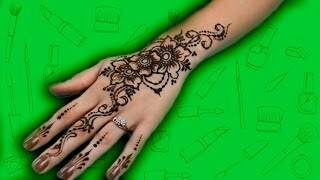 2:16
2:16  10:52
10:52 